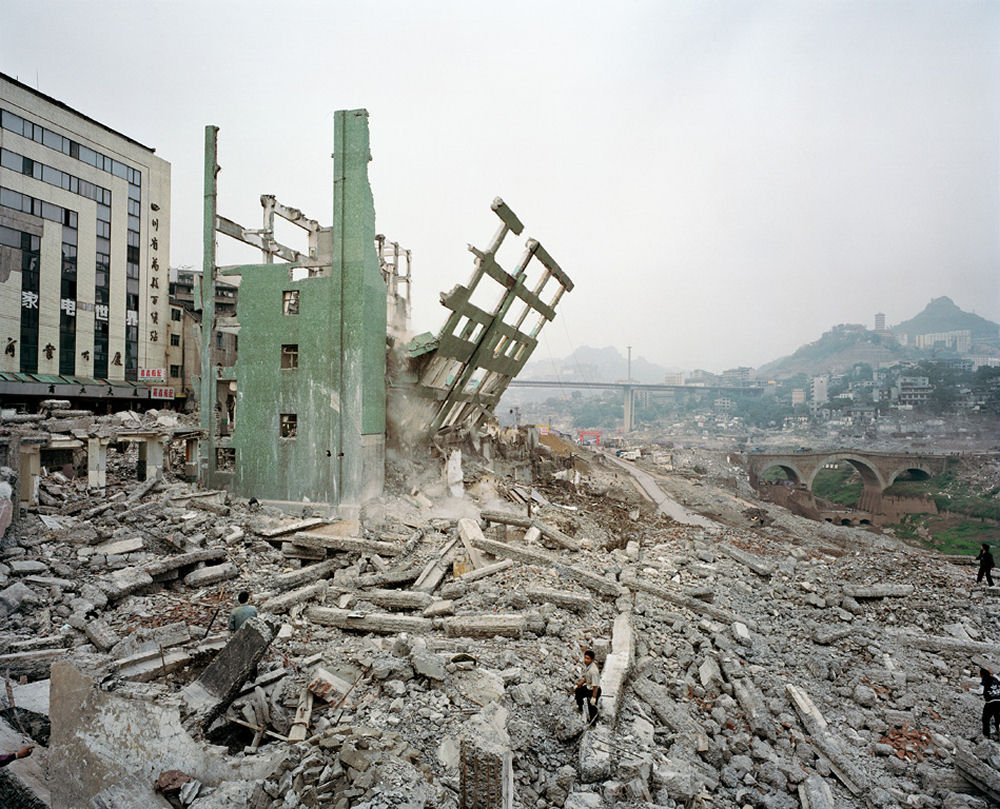
Just two days ago, Prime Minister Julia Gillard announced that:
“We can still be a country that manufactures things. But we’re going to have to do it differently”
She was spot on, if by differently she means we’ll make things without investing any capital. That will be very different indeed.
The truth is Australian manufacturing is not adapting, it’s being wiped out. It’s not restructuring, it’s flat out collapsing. Yesterday’s private capex survey was a bloodbath, sending manufacturing investment intentions back to levels last seen in the 2001 global recession, and first seen in 1989. And that’s in nominal dollars. Inflation adjusted is far worse. In the following chart of capex intentions, the arrow points to expected spending levels for the next year:
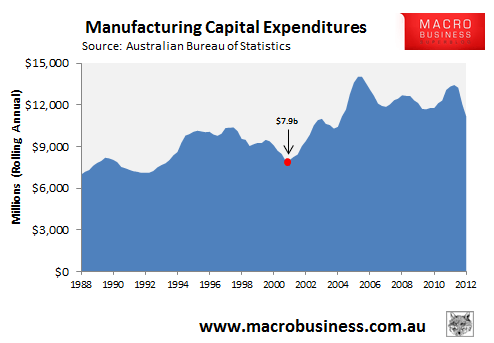
It was not always thus. It’s easy to forget, especially with a gorked media, that manufacturing’s proportion of capex matched that of mining until 2004:
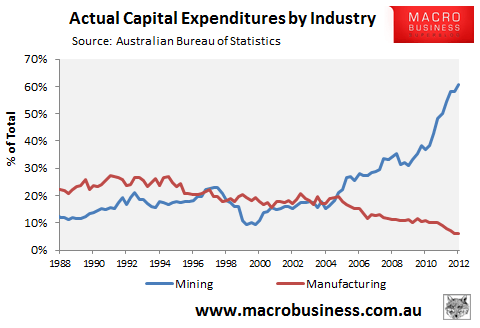
But now it’s all about the dirt:
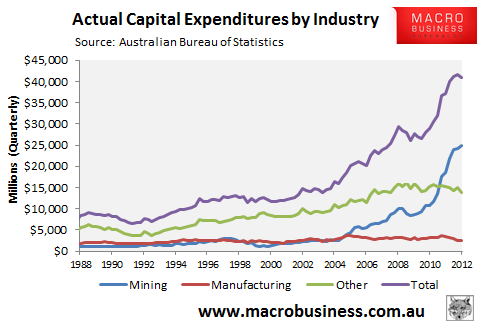
That’s fair enough. This post is not about bashing mining. What it is about is imbalances.
Australia’s economic elite – public and private – are engaged in a grand experiment. They have decided, in their wisdom, to delete Australia’s industrial base and replace it with mines.
This is changing us in all sort of ways that are not always obvious. For instance, the rise of the mining share of the economy is matched by a rise in political influence by miners. Mining now pays the rate of tax that it wants to, not what the elected government of the day would like it to. You can argue back on forth on the merits of this but it is fundamentally true. So, we have developed a political imbalance.
That may not bother you if you think free enterprise should be able to do what it likes. But there is a follow-on consequence. With policy neutered, there is no redress for the economic imbalances that also rise as mining dominates growth. It may be that we can keep digging and shipping dirt at such a furious pace and live for as long as we like on the income. So far it’s worked well enough. But a glance at history tells you that’s a long shot:
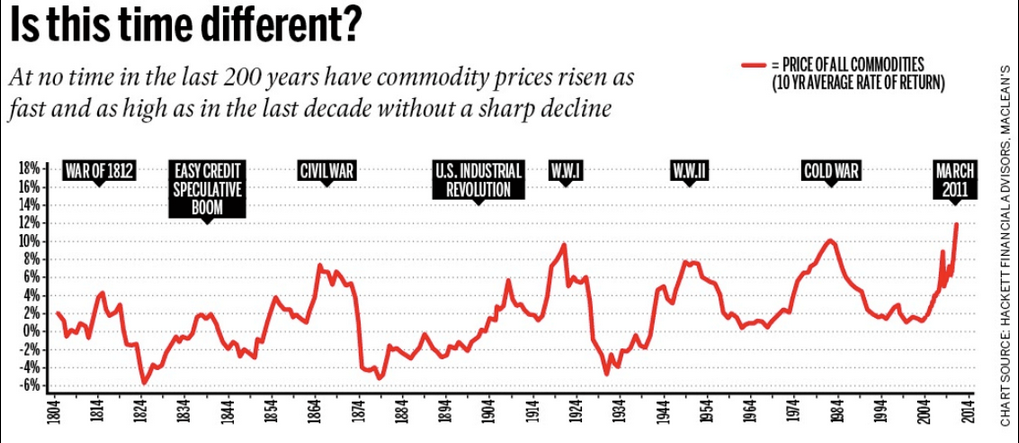
Each of the spikes in commodity prices in the past 200 years is the result of a global dislocation. Chinese development is just another and, although it is huge, it’s not big enough to outpace capitalism. Supply has already responded to shortages and it is only a matter of time before prices fall much further.
So, if history is brighter than Australia’s elite, that means our current mining-centric growth is also an imbalance in a number of ways. The first and most important is that without manufacturing, you are left with only two drivers of growth. One is mining investment, which is great. The other is services investment, which is also great except for one small problem.
The baby-boomer cohort that runs the show would have you believe we can build an empire from services, but we can’t. Services are not on their own a great creator of national wealth. The reason is pretty straight forward, for the most part they are not tradeable. As such they bring little in the way of earnings to the country. Services represent some 70% of the economy but only 15% of our export income.
That is not to say that you need to be a mercantilist nation to make money. Not at all. But without offsetting export income from other sectors, services don’t generate basic capital formation. Services amplify rather than create fundamental capital and they do that largely through the use of debt, which if overused can create its own imbalance. Australia is an example of this, with a services economy that has grown significantly on the back of leveraging export income from other sectors and in the process caused Australia’s major external imbalance, the current account deficit and the bank debts that fund it.
Manufacturing on the other hand is highly tradeable. Check out this chart from DFAT which measures the respective contributions of various sectors to Australian exports:
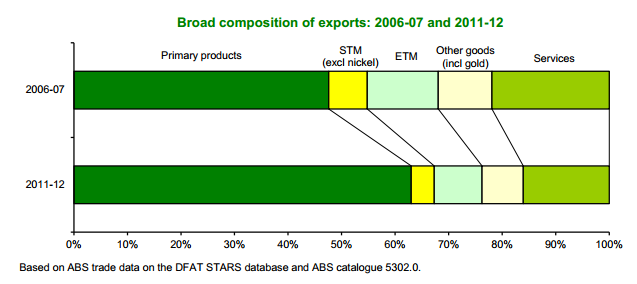
As recently as 2006/07, manufacturing contributed (STM & ETM) over 20% of Australian export revenue, virtually the same proportion of export revenue as services from a production base approximately one seventh the size. Ever since, manufacturing has been sent to the knackery and its share of exports is down now to 10% and still falling.
Which brings us to the second dimension of our imbalance: an over-reliance on mining revenues. When the commodity boom ends, manufacturing income will not rebound. Yesterday’s dire capex figure shows that there is increasingly no manufacturing left to do so. I suspect that manufacturers have held on grimly through the past three years of a high dollar but are now capitulating. A lack of manufacturing exports will exacerbate the post commodity boom downturn because the much touted services sector won’t be able to grow its borrowing anymore. This is basically what has happened to the UK economy.
This in itself points to several other imbalances. Manufacturing is a key sector when it comes to productivity growth. I expect we’ll enjoy a few good years of productivity as mining digests its extraordinary capital binge. But in the long term, productivity gains are most concentrated in increasing the output efficiency of stuff you make. Once established, mining doesn’t improve its efficiency much. Neither does services. Through investment in technology, manufacturing offers out-sized productivity gains for an economy.
That’s why the founding father of US industry, Alexander Hamilton, set about building a manufacturing powerhouse (though I’m not a protectionist). That’s why China has done it in the US’s image. Productivity is dynamic. It can be created through fostering manufacturing.
So this is another imbalance. Without manufacturing, productivity gains become more difficult and so does the capital formation that comes with it.
And there is another argument worth considering. Without a manufacturing base, how does a country defend itself? Sure, production can always be ramped up if needed in a time of strife. But not if you no longer posses the human capital to do it. The death of manufacturing is the permanent loss of the skills and intellectual property that enables such a ramp up to occur. It will be a short meeting when our enemy’s generals sits down to plan which industrial targets to bomb.
The various imbalances created by the annihilation of Australian manufacturing are neither inevitable nor benign. Our elite are pursuing one of the great experiments in national self-sabotage.

